Journey through biblical verses unveiling the complex bonds of brotherhood, where envy and love intertwine, inviting deeper reflection on familial ties.
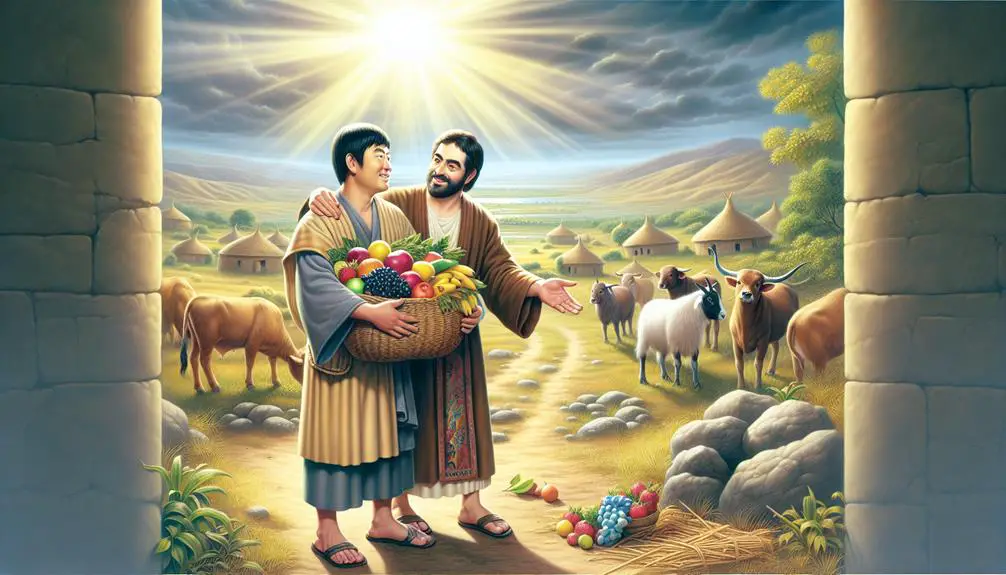
Brothers in the Bible Verses
You're scrolling through your social media feed when suddenly, the timeless tales of brotherhood from the Bible catch your eye, much like ancient tweets broadcasting familial sagas of envy, division, betrayal, and reconciliation.
From Cain and Abel's tragic fallout to the complex narratives of Isaac and Ishmael, or the epic journey of Joseph and his brothers, these stories offer more than just moral lessons; they provide a mirror to our own familial and societal dynamics.
As you ponder the depth of these relationships, you'll find yourself intrigued by the layers of meaning and emotion that these ancient texts encapsulate, compelling you to explore further the richness that lies within.
Key Takeaways
- Biblical narratives often highlight sibling rivalry, showcasing themes of envy, conflict, and eventual reconciliation.
- Stories of brothers like Cain and Abel, and Jacob and Esau, underscore lessons on the consequences of jealousy and betrayal.
- The relationship between Jonathan and David exemplifies sacrificial friendship and loyalty beyond familial bonds.
- Divine preference in sibling dynamics can exacerbate human jealousy, yet offers opportunities for spiritual reflection on forgiveness and unity.
Cain and Abel: Fraternal Envy
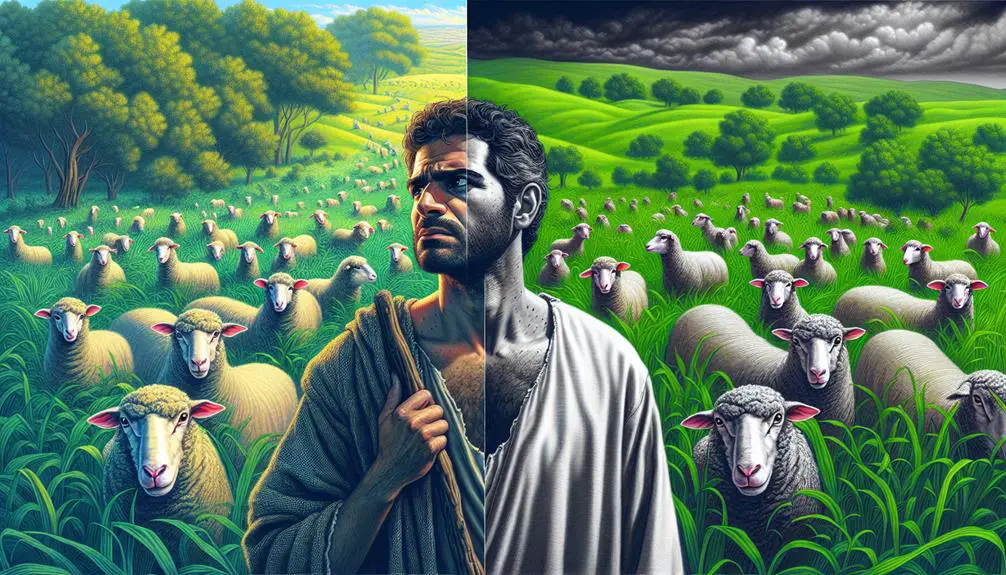
In the biblical narrative of Cain and Abel, fraternal envy acts as a catalyst for the unfolding of one of the earliest and most profound tragedies within human relationships. You're immediately thrust into a world where sibling rivalry transcends mere jealousy, morphing into a deadly sin with irreversible consequences. This tale is emblematic of the destructive potential harbored within the bonds of blood, showcasing how a seemingly benign emotion can escalate into a catastrophic outcome.
The story of Cain and Abel isn't just a narrative about murder; it's a complex examination of sacrificial symbolism and the inherent competition between siblings. Abel's offering finds favor with God, while Cain's does not. This distinction sets the stage for a deeper analysis. The sacrificial symbolism here isn't merely about the offerings themselves but represents the brothers' hearts and intentions. Abel's sacrifice, coming from the flock, perhaps reflects a purer, more sincere heart in contrast to Cain's offerings from the fruits of the ground. This narrative invites you to consider the role of intent in human actions and the ways in which divine preference can exacerbate human jealousy.
Cain's response to God's rejection exemplifies the extreme end of sibling rivalry, where envy leads not just to estrangement but to the annihilation of the other. This act of fratricide serves as a harrowing reminder of the potential for envy to destroy not only the envied but the envier as well. Through Cain and Abel, you're called to ponder the complexities of fraternal relationships and the dark shadows that can lurk within them.
Isaac and Ishmael: Divided Heritage

You must consider the complex dynamic between Isaac and Ishmael as foundational to understanding the origins of fraternal conflict within biblical narratives.
Their story, marked by a divided heritage, offers critical insights into attempts at reconciliation between brothers.
Analyzing their relationship not only sheds light on personal family struggles but also on broader themes of division and unity within the biblical text.
Fraternal Conflict Origins
The biblical narrative of Isaac and Ishmael unveils a complex tapestry of fraternal conflict rooted in a divided heritage. This story is pivotal in understanding sibling rivalry origins within a sacred context.
Their tale begins with shared blood but diverges into a saga marked by distinct covenants with God, setting the stage for the development and eventual strain of fraternal bonds. This divergence is emblematic of the broader theme of chosenness and rejection, deeply ingrained in the fabric of their lineage.
As you delve deeper, you'll see how their individual journeys reflect a dynamic interplay between divine promise and familial allegiance, laying the groundwork for a conflict that transcends generations. This narrative doesn't just recount historical events; it explores the profound implications of divided inheritances on sibling relationships.
Reconciliation Attempts
Amidst a backdrop of deep-seated division, attempts at reconciliation between Isaac and Ishmael emerge as pivotal moments in their storied heritage. The narrative arc of family restoration through peaceful mediation underscores the complexity of their relationship and the broader implications for their descendants.
- Momentary Peace: A fleeting encounter that hints at the possibility of unity.
- Shared Grief: The death of their father, Abraham, brings them together, symbolizing a temporary bridge over their chasm of estrangement.
- Cultural Legacy: Their eventual paths underscore the importance of reconciliation in preserving family bonds across generations.
- Spiritual Reflection: This narrative invites introspection on the power of forgiveness and the enduring hope for family restoration.
These moments of attempted reconciliation highlight the profound impact of peaceful mediation in the face of entrenched familial discord.
Jacob and Esau: Birthright Betrayal
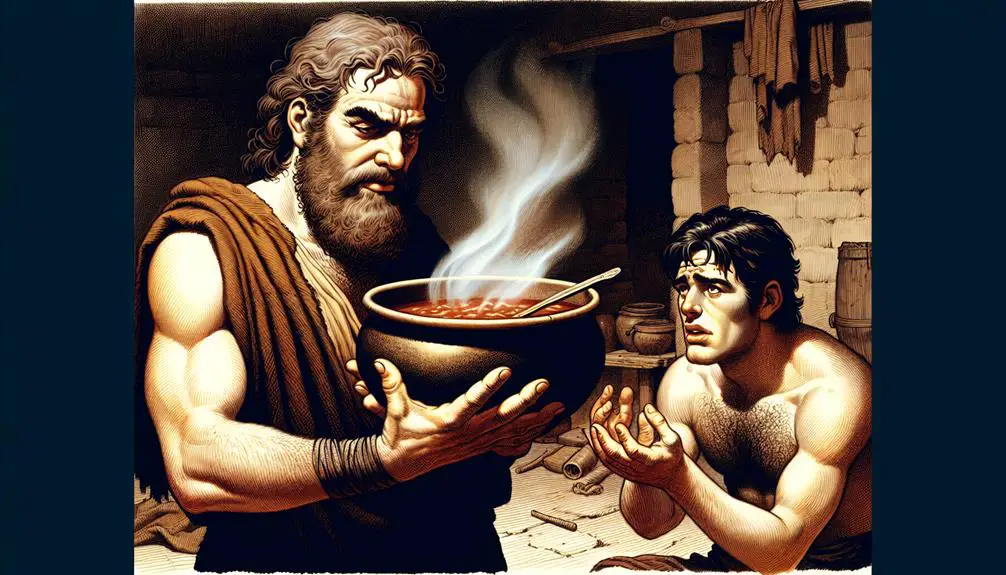
In examining the story of Jacob and Esau, it becomes evident how a single moment of vulnerability led to the irrevocable transfer of Esau's birthright to his younger brother, Jacob. This narrative, deeply entrenched in the themes of parental favoritism and destiny manipulation, unveils the complexities of human relationships and divine interventions. The preference of Isaac for Esau and Rebekah for Jacob set a stage for rivalry and deceit that ultimately shaped the course of their family's history.
Parental favoritism isn't merely a backdrop but a catalytic force driving the narrative forward. Isaac's inclination towards Esau, primarily for his hunting prowess, contrasts sharply with Rebekah's affinity for the quieter, homebound Jacob. This divide sows seeds of manipulation, as Rebekah aids Jacob in deceiving Isaac to secure the blessing meant for Esau. The act of trickery, while ensuring Jacob's ascendancy, also foretells the tumultuous journey ahead, marked by conflict and displacement.
Destiny manipulation emerges as a pivotal theme when Jacob capitalizes on Esau's immediate physical need to usurp the birthright. This moment, emblematic of opportunism, underscores a broader divine orchestration at play. Despite the moral ambiguity of Jacob's actions, the narrative subtly suggests that his ascendancy was preordained, challenging the reader to ponder the interplay between divine will and human agency.
The story of Jacob and Esau, with its intricate web of familial loyalty, betrayal, and redemption, serves as a profound exploration of the human condition. It prompts a reflection on the consequences of our choices, the imperatives of destiny, and the possibility of reconciliation despite deep-seated grievances.
Joseph and His Brothers: Jealousy and Reconciliation
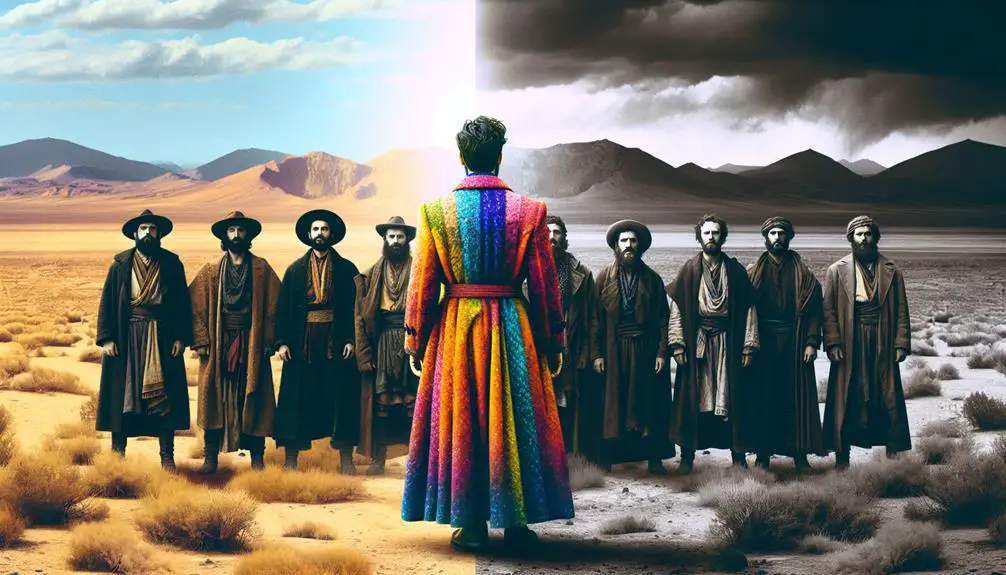
You'll notice that the narrative of Joseph and his brothers pivots around themes of envy, betrayal, and eventual forgiveness.
Joseph's ability to interpret dreams sets him apart, leading to his brothers' envious plot against him, a pivotal moment that underscores the complexities of familial relationships in biblical texts.
This path to forgiveness, marked by recognition and reconciliation, offers a profound exploration of redemption and the power of familial bonds.
Joseph's Dream Interpretation
Understanding Joseph's ability to interpret dreams reveals not only his unique gift but also the underlying tensions and eventual reconciliation among his brothers, illustrating a pivotal moment in biblical narratives of jealousy and unity. Joseph's interpretations, marked by profound dream symbolism, were pivotal in transforming his life and the lives of those around him, including his brothers.
- Joseph's interpretations showcased his divine wisdom, setting the stage for reconciliation.
- His accurate reading of Pharaoh's dreams earned Pharaoh's gratitude, leading to his rise in Egypt.
- This elevation was critical in saving his family from famine, highlighting the theme of provision and forgiveness.
- It eventually fostered an emotional reunion, turning jealousy into joy and conflict into peace, underscoring the power of forgiveness and foresight.
Brothers' Envious Plot
While Joseph's dream interpretations heralded a path towards reconciliation, his brothers' envy set the stage for a plot that would test the bonds of family and faith. Sibling rivalry, deeply rooted in their history, escalates as Joseph's favoritism becomes apparent. This envy isn't just a fleeting emotion; it's a catalyst for actions that will ultimately lead to emotional healing, though the journey is fraught with hardship.
Aspect |
Impact |
|---|---|
Sibling Rivalry |
Seeds of discord, leading to the plot. |
Envy |
Drives the brothers to conspire. |
Emotional Healing |
A distant, but inevitable outcome. |
Understanding the dynamics at play in Joseph's story reveals much about the complexities of family relationships and the power of forgiveness, themes that transcend time.
Path to Forgiveness
Although the road to reconciliation was long and fraught with challenges, Joseph's capacity for forgiveness became a pivotal moment in the biblical narrative, illustrating the transformative power of forgiveness in overcoming jealousy and restoring familial bonds. This journey, rich in forgiveness rituals and emotional healing, offers profound lessons:
- Acceptance: Recognizing the hurt allows for the initial steps towards emotional healing.
- Empathy: Understanding the perspectives of those who wronged you fosters compassion.
- Forgiveness Rituals: Engaging in acts that symbolically represent forgiveness can bridge emotional gaps.
- Reconciliation: The ultimate goal, restoring broken relationships, is achieved through persistent love and forgiveness.
These elements highlight the critical role forgiveness plays in healing and reuniting, serving as a blueprint for overcoming discord and fostering enduring connections.
Moses, Aaron, and Miriam: Leadership and Support
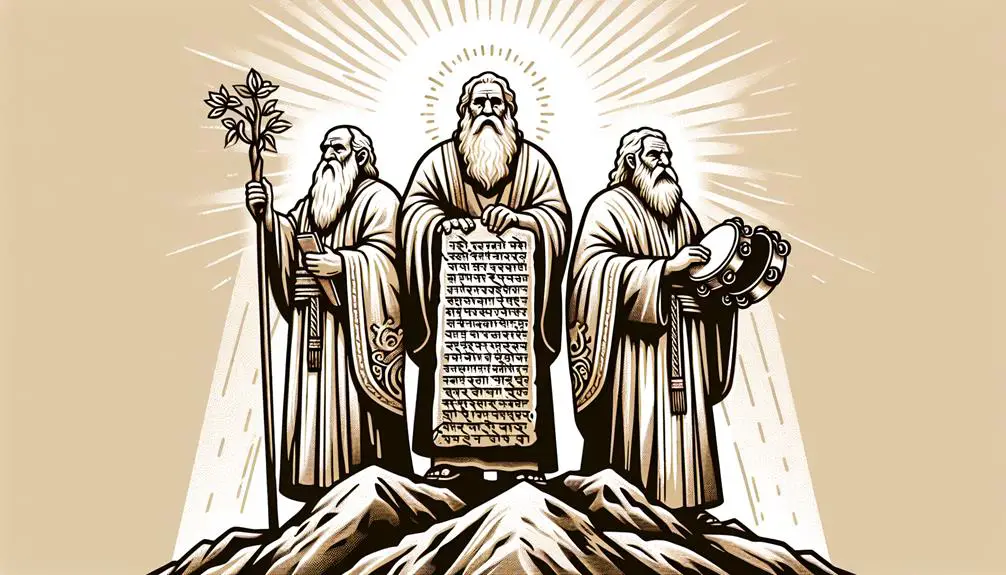
In the narrative of Moses, Aaron, and Miriam, we observe a dynamic interplay of leadership and support that underscores their collective contribution to the Israelites' journey and spiritual evolution. You'll find that their roles were not merely supportive in nature but pivotal in shaping the destiny of their people. Through Miriam's leadership and Aaron's priesthood, a foundation was laid for a spiritual and communal structure that would endure.
Miriam, initially introduced as Moses' watchful sister, emerges as a leader in her own right. Her song of triumph after crossing the Red Sea is one of the earliest examples of prophetic leadership, celebrating deliverance and inspiring faith among the Israelites. Aaron's role as high priest established a religious order that provided guidance and atonement for the people, serving as a mediator between them and God.
Aspect |
Significance |
|---|---|
Miriam's Role |
Demonstrates the power of faith and the importance of women in leadership and spiritual roles. |
Aaron's Role |
Embodies the establishment of a sacred priesthood, guiding religious practices and rituals. |
Collective Impact |
Their synergy illustrates how leadership, support, and spiritual guidance are intertwined. |
Legacy |
Sets a precedent for future generations on the balance of spiritual and communal leadership. |
Analyzing these figures reveals how intertwined leadership and support are in achieving a greater purpose. Their stories teach us the value of collective effort, spiritual resilience, and the enduring nature of faith-based leadership.
The Prodigal Son: Forgiveness and Return

Exploring the parable of the Prodigal Son, you'll uncover profound themes of forgiveness and the transformative power of return. This narrative, deeply embedded in Christian theology, offers a poignant examination of human fallibility and the boundless capacity for redemption. At its heart, the story revolves around a young man who squanders his inheritance, only to face the harsh realities of his actions. Yet, it's in his return that the narrative finds its most compelling elements of grace and reconciliation.
Consider these aspects to evoke emotion and deepen understanding:
- The Pain of Lost Inheritance: The moment the son realizes the depth of his folly, losing not just material wealth but his place within his family, is a stark reminder of the consequences of our choices.
- The Humility in Return: His decision to come back, expecting nothing but hoping for mercy, speaks volumes about the humility required for true transformation.
- The Father's Unconditional Love: The father's response, running to meet his son and embracing him, underscores the unconditional nature of divine forgiveness.
- The Celebratory Feast: This act not only signifies the son's restoration to his family but also represents the joy that accompanies reconciliation and the renewal of broken relationships.
Through this narrative, you're invited to reflect on the essence of forgiveness, the possibility of starting anew, and the joy that comes from restored connections. The Prodigal Son's journey from recklessness to redemption encapsulates a universal message: it's never too late to return, and the path back is always met with open arms.
James and John: Ambition and Service
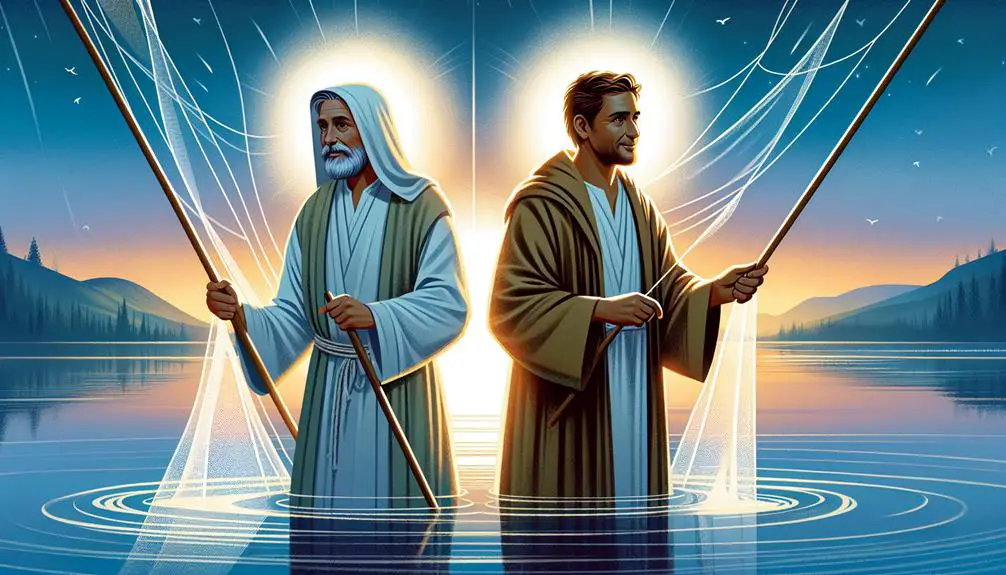
CURRENT SUBTOPIC: 'James and John: Ambition and Service'
How do the ambitions of James and John reflect the complex interplay between personal desires and the call to service within biblical narratives? As sons of Zebedee, their story begins with a foundation steeped in Zebedee's legacy, which presumably includes expectations and societal roles. Yet, their journey with Jesus marks a pivotal shift from seeking personal glory to embodying the essence of Apostolic missions. This transformation is not just about abandoning personal ambitions but about redefining success through the lens of service and sacrifice.
Aspect |
Before |
After |
|---|---|---|
Ambition |
Seek positions of power |
Serve the least and the lost |
Understanding of Power |
Earthly dominion |
Spiritual authority |
Legacy |
Zebedee's influence |
Apostolic missions |
Service |
Limited to personal gain |
Centered on community upliftment |
Sacrifice |
Avoided |
Embraced as part of their mission |
You see, their ambition, initially rooted in earthly success and recognition, becomes transformed. The brothers learn that true leadership in the context of their faith is not about lording over others but serving them. This lesson, deeply embedded in the fabric of their Apostolic missions, signifies a departure from the conventional expectations set by Zebedee's legacy.
The narrative of James and John is a compelling exploration of how personal desires can evolve into a life dedicated to service and the greater good. It's a reminder that ambition, when channeled through the prism of faith and service, can lead to profound societal impact. Their story isn't just about the renunciation of personal desires; it's a reimagining of what those desires can achieve when aligned with a higher calling.
David and Jonathan: Covenant Friendship
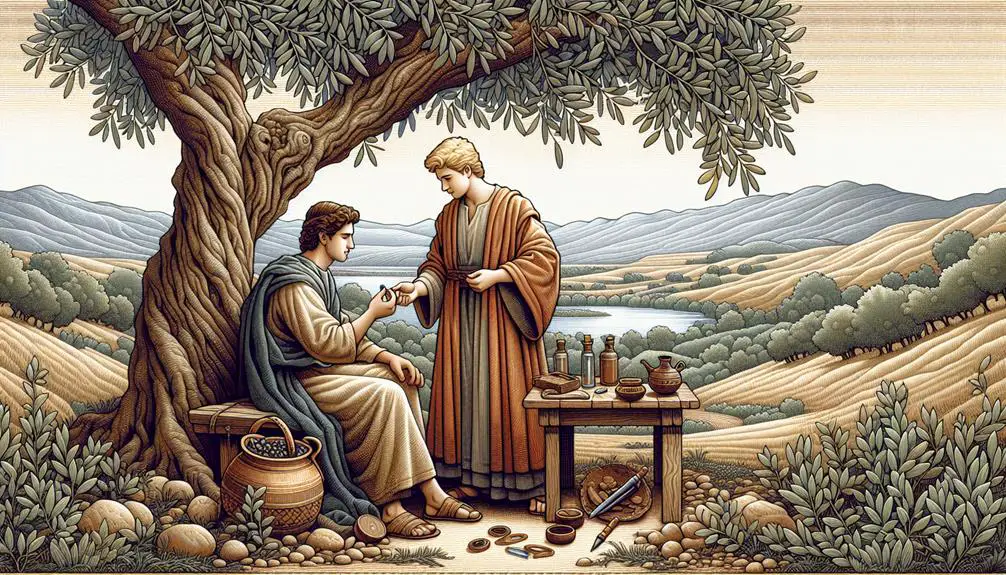
While James and John's story unveils the transformation of ambition through service, the narrative of David and Jonathan offers a profound exploration of covenant friendship within the complexities of biblical loyalty and devotion. At the heart of their relationship is a bond that surpasses mere political alliance or familial obligation. It's a testament to the depth of connection that can exist between individuals, underscored by Jonathan's loyalty and culminating in David's mourning upon Jonathan's death.
In analyzing their friendship, four key elements emerge:
- Covenant Over Convenience: Jonathan's allegiance to David, even at the potential cost of his own claim to the throne, reflects a covenantal friendship that values the other's well-being above personal gain.
- Mutual Respect and Affection: Their relationship is marked by a mutual respect and affection, rare in the often tumultuous and competitive context of biblical narratives.
- Sacrificial Loyalty: Jonathan not only risks his position but his life, demonstrating a loyalty that transcends conventional expectations.
- Enduring Grief: David's mourning for Jonathan is poignant, encapsulating the depth of their bond and the void left by Jonathan's absence.
This story encourages you to reflect on the nature of friendship and loyalty. Jonathan's unwavering support and David's profound grief reveal the strength and vulnerability inherent in true companionship. Their story, nestled within the broader biblical narrative, offers timeless insights into the essence of friendship, loyalty, and the human condition.
Frequently Asked Questions
How Have Modern Interpretations and Adaptations of These Biblical Brother Stories Influenced Contemporary Views on Brotherhood and Familial Relationships?
You've seen how modern adaptations of sibling stories have reshaped our views on brotherhood and familial dynamics.
By analyzing these narratives, you'll notice that contemporary interpretations often emphasize the complexity of sibling rivalry, diverging from traditional portrayals.
This shift not only reflects changes in societal values but also encourages a deeper understanding of family relationships.
As a result, you're better equipped to navigate the nuances of your own familial ties.
Are There Any Archaeological Findings or Historical Evidence That Support the Existence or Events of These Biblical Brothers?
Imagine digging through ancient layers of history, where archaeological methodologies meet dusty relics. You're seeking evidence that supports ancient narratives.
While archaeological findings and historical debates enrich our understanding of the past, pinpointing direct evidence for specific biblical events, especially those involving individual characters, remains challenging. Analysis often relies on broader context and artifacts that illuminate the era's culture and practices, rather than direct proof of personal stories.
How Do These Stories of Brothers in the Bible Reflect the Societal and Cultural Norms of Their Times, and What Lessons Can We Learn About Change and Continuity in Family Dynamics?
You're diving into how stories mirror societal norms and teach us about family dynamics' evolution. Sibling rivalry isn't just a tale as old as time; it's a lens through which cultural reflections of change and continuity are vividly seen.
In What Ways Have These Biblical Brother Stories Been Utilized in Different Religious Teachings or Moral Instructions Outside of Christianity and Judaism?
Ironically, without even trying, biblical brother tales have wandered into interfaith dialogues and mythological comparisons, showing their universality.
You'll find these stories repurposed in various religious teachings, serving as a bridge for moral instruction beyond Christianity and Judaism.
They offer a rich canvas for analyzing change and continuity in human relations, providing a scholarly look at how ancient narratives influence contemporary ethical frameworks across different cultures and religions.
Can the Themes of Rivalry, Reconciliation, and Redemption Found in These Biblical Brother Stories Be Paralleled With Any Similar Narratives in Other Religious Texts or Mythologies Around the World?
You'll find that themes of rivalry, reconciliation, and redemption aren't unique to any one tradition. Across the globe, mythological parallels in stories from various cultures reflect these universal experiences.
Cultural adaptations of these narratives showcase how societies grapple with similar moral and ethical issues. Whether in ancient Greek myths, Hindu epics, or Native American folklore, the core human experiences of conflict and resolution are mirrored, illustrating a shared human condition.
Conclusion
In the tapestry of biblical narratives, the threads of brotherhood intertwine, revealing patterns of envy, division, betrayal, jealousy, leadership, forgiveness, ambition, and covenantal friendship.
You've journeyed through stories where fraternal bonds are tested, sometimes fracturing under the weight of inheritance, birthrights, and dreams, yet also mending through acts of reconciliation and support.
These narratives serve not merely as ancient texts but as mirrors, reflecting the complexities of human relationships and the potential for transformation within them.

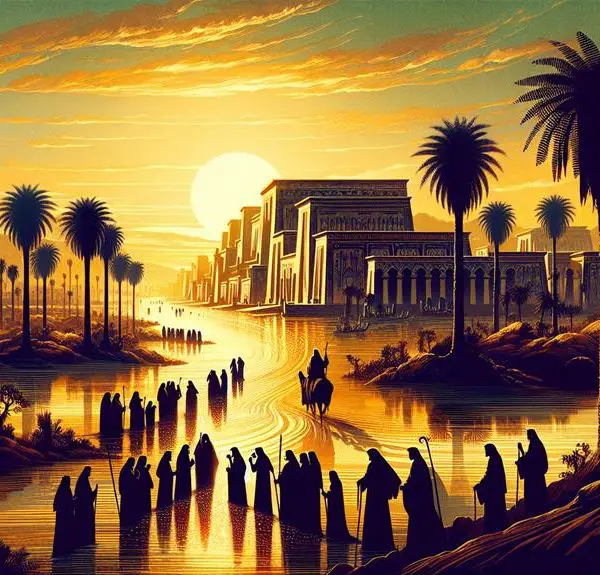

Sign up